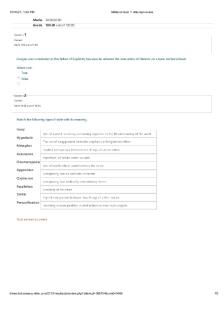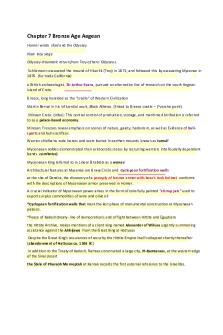MAT1330 Midterm 1 PDF

| Title | MAT1330 Midterm 1 |
|---|---|
| Course | Calculus for the Life Sciences I |
| Institution | University of Ottawa |
| Pages | 7 |
| File Size | 176.3 KB |
| File Type | |
| Total Downloads | 93 |
| Total Views | 124 |
Summary
Download MAT1330 Midterm 1 PDF
Description
Universit´ e d’Ottawa
page 1 of 7
University of Ottawa
MAT1330 B – Instructor: Elizabeth Maltais Wednesday, October 3, 2017 : Test #1 Duration: 75 minutes
Facult e ´ des sciences Mathematiques ´ et statistique
Family name:
Faculty of Science Mathematics and Statistics 613–562–5864 613–562–5776 www.uOttawa.ca
First name: Student number : For picking up your graded test: Circle the DGD you will attend to pick up your test registered or not). Tests take at least one week to announcements in class. #: DGD1 DGD2 DGD3 Day : Tuesday Wednesday Wednesday Start time: 10:00 10:00 1:00 Room : MRT 250 SMD 224 STE J0106 TA : Eric Rabib Rabib
585 King Edward Ottawa ON K1N 6N5
(whether you are grade; watch for DGD4 Thursday 11:30 FTX 133 Rabib
Please read the following instructions carefully. • You have 75 minutes to complete this exam.
• This is a closed book exam. Except for Faculty-approved calculators (models: Texas Instruments TI-30* and TI-34*, Casio FX-260* and Casio FX-300*), no notes, cell phones, smartwatches or related devices of any kind are permitted. All such devices, including cell phones, must be stored in your bag under your desk or at the front of the room for the duration of the exam. • Read each question carefully — you will save yourself time and grief later on. • Questions 1 through 6, and 8, are multiple choice, worth a total of 7 points. Record your answers to the multiple choice questions in the boxes provided. • Questions 7, 9, 10 and 11 are long answer, with number of points as indicated. You must show your work, your work must be legible and welljustified, and you must record your answers in the spaces provided. • Where it is possible to check your work, do so. •
Good luck!
Marker’s use only: Question
1–6,8 (/7) 7 (/2) 9 (/2) 10 (/5) 11 (/4) Total (/20)
Marks
Universit´ e d’Ottawa
page 2 of 7
University of Ottawa
1. (1 point) Find all real solutions of |1 − 2x2 | = 7. A. B.
±2 √ ± 2
√ ± −3
C.
No solutions exist.
E.
D.
±3
F.
0
E.
x > −1
Your answer:
ln(1 − 2x) 2. (1 point) What is the domain of f (x) = √ x+1 A.
all x
C.
B.
x>0
D.
−1 < x < x≥
1 2
1 2
?
F.
1 2
0 ?
Your answer:
5. (1 point) Does there exist a choice of a which makes the following function continuous at x = 1? If yes, which one? If not, why not? ( ln(2ax) if x > 1 f (x) = cos(πx) if x ≤ 1 A.
yes, a = e 1 −1 e 2 1 2
B.
yes, a =
C.
yes, a =
D.
yes, a = 0
Your answer:
E.
no, lim f (x) exists, but is not equal to f (1) for any choice of x→1 a so f can never be continuous at 1
F.
no, lim f (x) does not exist for any choice of a, so f can never x→1
be continuous at 1
Universit´ e d’Ottawa
6. (1 point) If h(x) = A. B.
1 2 1 lim h(x) = x→∞ 4 lim h(x) =
x→∞
page 4 of 7
University of Ottawa
1006 + 222x + 317x2 4024 + 554x + 634x2 C. D.
then
lim h(x) = 1
E.
lim h(x) = 0
F.
x→∞ x→∞
lim h(x) = −∞
x→∞
lim h(x) = ∞
x→∞
Your answer:
7. (2 points) Evaluate the following limit, if it exists. You must use algebraic methods and justify your answer mathematically to earn credit for this question. lim−
x→4
x2 − x − 12 |x − 4|
Your answer:
Universit´ e d’Ottawa
page 5 of 7
University of Ottawa
8. (1 point) A study started tracking a herd of elk in northern Alberta. In January 1996, there were 1000 elk in the herd. Over the course of this study, scientists observed that the elk had a natural growth rate of 5% each year. Furthermore, in December each year, an average of 50 elk were killed by hunters. If ht represents the herd’s population (in January), t years after 1996, which of the following DTDS models the dynamics of this herd? A.
ht+1 = 5ht + 950
C.
B.
ht+1 = 50ht − 1000
D.
ht+1 = 1.05ht − 50
ht+1 = 1.05ht + 950
E. F.
ht+1 = 0.05ht − 50 50 ht+1 = ht + 0.05 1000
Your answer:
9. (2 points) Find all solutions of the inequality. Show your work and justify your reasoning. x x−3 < x−5 x−1
Your answer:
Universit´ e d’Ottawa
page 6 of 7
University of Ottawa
10. (1+1+2+1=5 points) A population of snails grows according to a Ricker model, so that the DTDS governing the growth of this population’s density is given by
xt+1 = 2xt e1−0.4xt where t is in months and xt denotes the number of snails per m2 at time t. (a) Give the updating function of this DTDS. f (x) = (b) Find all fixed points x∗ of this DTDS. Show your work.
Fixed points: (c) The graph of y = f (x) is drawn below. Label the axes, identify the fixed points of the DTDS on the graph, then draw a cobweb for at least three iterations, starting with an initial population density of x0 = 1. Use your student card as a straight edge.
(d) What do you conclude will happen to this population of snails in the long term? (Your answer should be a complete sentence and should refer to the concepts of stability and fixed points as they pertain to this population of snails and your cobweb.)
Universit´ e d’Ottawa
page 7 of 7
University of Ottawa
11. (1+2+1=4 points) A patient is given a daily dose of the drug ToxicPlacebo, which is absorbed into the patient’s system at a constant rate. A DTDS modeling the concentration of drug xt , in mg/L in the patient’s bloodstream each day just after receiving the dose is given by xt+1 = 0.9xt + 0.5, where t is measured in whole days since the treatment began. (a) Find the fixed point of this DTDS, and give the general solution to this DTDS if the initial value is x0 = 1 mg/L. Fixed point: x∗ =
General solution:
=
(b) If the initial value is x0 = 1 mg/L, find the number of whole days it takes for the concentration of ToxicPlacebo in the patient’s bloodstream to reach at least 4.5 mg/L.
Minimum number of whole days required: (c) Surprisingly, testing over the year reveals that the concentration of ToxicPlacebo in the patient’s bloodstream has stabilized to x∗ = 6 mg/L. An investigation reveals that the doctor’s bad handwriting was to blame, and the administered daily dose d in reality was not actually 0.5 mg/L. What was it?...
Similar Free PDFs

MAT1330 Midterm 1
- 7 Pages

Midterm 1
- 2 Pages

Midterm 1
- 3 Pages

Pexam 1 - practice midterm 1
- 1 Pages

CS122a F20Midterm 1 - Midterm 1
- 15 Pages

Psychology midterm 1 review
- 19 Pages

Midterm 1 notes
- 20 Pages

Midterm 1 Notes
- 4 Pages

Business 70 Midterm 1
- 19 Pages

Midterm 1, questions
- 10 Pages

FMPH 110 Midterm 1
- 7 Pages

Past Midterm #1
- 12 Pages

ENGL6100 - Midterm QUIZ 1
- 5 Pages

Notes for midterm 1
- 5 Pages

Midterm 1 cheat sheet
- 1 Pages
Popular Institutions
- Tinajero National High School - Annex
- Politeknik Caltex Riau
- Yokohama City University
- SGT University
- University of Al-Qadisiyah
- Divine Word College of Vigan
- Techniek College Rotterdam
- Universidade de Santiago
- Universiti Teknologi MARA Cawangan Johor Kampus Pasir Gudang
- Poltekkes Kemenkes Yogyakarta
- Baguio City National High School
- Colegio san marcos
- preparatoria uno
- Centro de Bachillerato Tecnológico Industrial y de Servicios No. 107
- Dalian Maritime University
- Quang Trung Secondary School
- Colegio Tecnológico en Informática
- Corporación Regional de Educación Superior
- Grupo CEDVA
- Dar Al Uloom University
- Centro de Estudios Preuniversitarios de la Universidad Nacional de Ingeniería
- 上智大学
- Aakash International School, Nuna Majara
- San Felipe Neri Catholic School
- Kang Chiao International School - New Taipei City
- Misamis Occidental National High School
- Institución Educativa Escuela Normal Juan Ladrilleros
- Kolehiyo ng Pantukan
- Batanes State College
- Instituto Continental
- Sekolah Menengah Kejuruan Kesehatan Kaltara (Tarakan)
- Colegio de La Inmaculada Concepcion - Cebu
